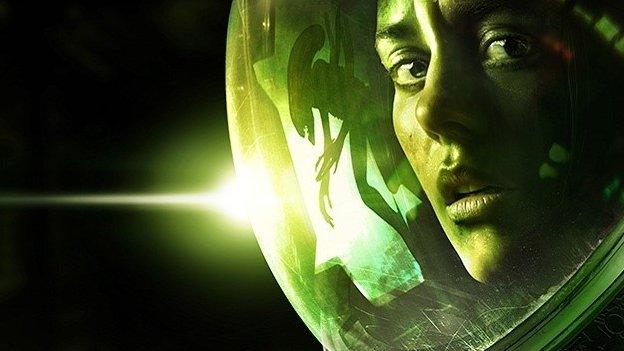League of Legends gaming final fills Seoul stadium
- Published
Thousands turned up for the League of Legends World Championship in Seoul
It had all the sound and fury of a big sporting event: 40,000 fans roaring in the cauldron of a huge football stadium.
There were corporate sponsors, young superstar players and a million dollar prize to the winner.
And yet this raucous contest involved barely a drop of sweat and absolutely no muscular exertion beyond the furious clicking of fingers on a computer mouse.
The final of the 2014 League of Legends World Championship may only have been an online game - or e-sport, as the players and promoters prefer to call it - but it had all the feel of any traditional major sporting drama.
The World Cup stadium in Seoul was packed for this year's final between the Star Horn Royal Club from China and Samsung White.
At the previous final a year ago, 32 million people watched around the world, online, or in cinemas.

League of Legends games pit two teams of Champions against each other
This time, gamers all over the world crowded to cinemas at odd times of the day depending on the time zone.
In Glasgow, Scotland, for example, gamers and fans were lining up to watch at 0730 BST.
Team appeal
The appeal of the final lies in the appeal of the title.
League of Legends is a team game, with each member of the five-member team taking on the role of a particular character or Champion online.
Each team member operates his own Champion.
Different Champions or on-screen characters have different characteristics - one may be powerful but with little stamina, so he, or she, or it, is good at killing, but can't last, and so is more likely to be killed once time has passed.
Another might be meek but stealthy, and so able to last for longer, but be less effective early on.
These combinations of characteristics mean tactics are important.
The aim is for one side to kill the Champions of the other and to achieve goals like capturing a turret in a fortress.
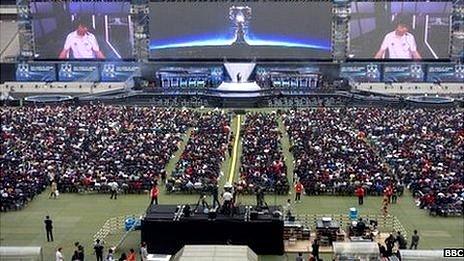
Two teams of five players competed in the final at the football stadium
It's a game of the brain as well as speed of reflex.
As the game's blurb puts it: "Two teams of powerful champions, each with a unique design and play style, battle head-to-head across multiple battlefields and game modes."
Free to play?
The game was developed by Riot Games of Santa Monica, California.
On the industry reckoning, about 27 million people play it every day. At peaks, there may be more than seven million gamers playing it at the same time.
It has taken off because of its combination of split-second timing with strategy. And because it's free to play.
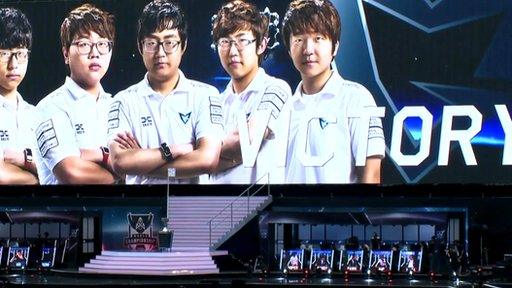
Samsung White beat Star Horn Royal Club to win $1m in the e-sports competition
Riot Games has come up with a shrewd pricing system. It's free to get online and into action, but extras - like a particular look to a character you want as your own - costs money.
And that's all added up to a revenue for the company of more than $600m (£372m) last year, as well as up to the tens of thousands of fans streaming into the big football stadium in Seoul.
One spectator, Tex Kang, said: "It's huge. It's the biggest e-sports game. You can do college courses in it."
He said there were even divisions of the South Korean military devoted to it. Conscripts who were skilful enough could represent the military in competitions.
He admitted it was mostly men who played, though there were a few women's teams.
Looking at the crowd in Seoul for the grand final, it did seem that men vastly outnumbered women, perhaps even more than at an average football match.
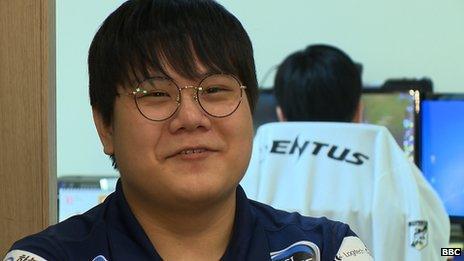
Star player Sun ho-san aims to practice for 10 hours a day
Though the e-sports atmosphere in the stadium, it should be said, was much less macho than football - no aggressive chanting just lots of cheering and laughing.
Human champions
The players at the top of the game - the human ones not the cyber-Champions - earn a fortune and lots of adulation. At the event in Seoul, the camera picked out successful players and roars of approval went up.
This phenomenal success attracts sponsors and all the razzmatazz of commercialism. Fans line up for posters and swag.
Sponsors grappling for a part of the action operate in all kinds of different industries - from food to pharmaceuticals to media.
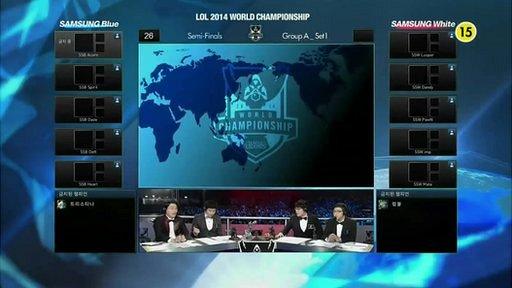
A team of commentators helped analyse the two team's battle tactics
One sports marketing specialist from South Korean firm CJ told the BBC that the company paid the players' wages as well as providing accommodation and practice facilities - a room with computers.
"My company is very big in Korea but we aren't that big in the rest of the world," Mr Yoosang said.
"Our strategy is to expand our brand image to other countries and we think e-sport is a good way to enhance our image," he continued.
He's coy about saying how much the company puts in and the players are coy about saying how much they're paid.
Sun ho-san is a be-spectacled shy boy who's a star. "My life is a bit different from others," he told the BBC.
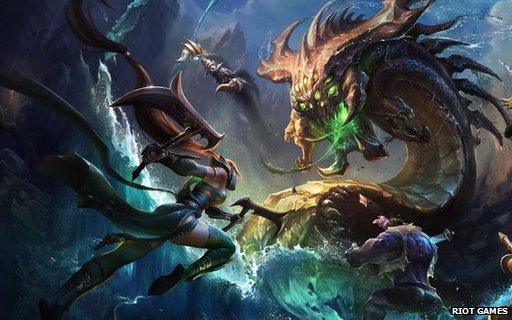
League of Legends' developer, Riot Games, says it has the world's largest online gaming community
"I get up when other people have lunch. If you want to aim for the championship 10 hours of practice a day is the least I can do.
"At the end of games fans come to me and give me snacks and approval."
He's 22 years old and he has no other career. He admits that he is a bit worried about life after gaming.
"I would be lying if I said I'm not worried but being successful as a gamer is quite lucrative so my aim is train really hard," he said.
For the record, the winners of the grand final in Seoul were the Samsung White team.
Their hyper-speed on the mouse earned a prize of $1m (£621,267).
- Published17 October 2014
- Published16 October 2014
- Published15 October 2014

- Published7 October 2014
